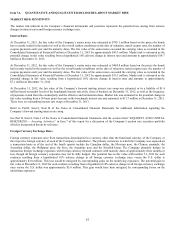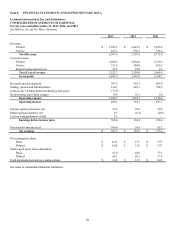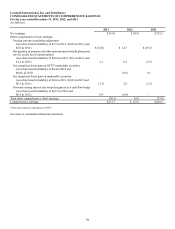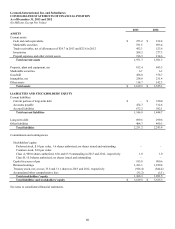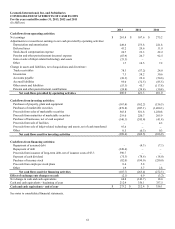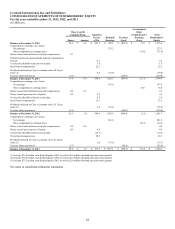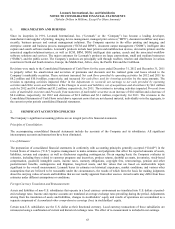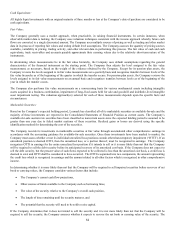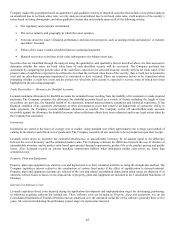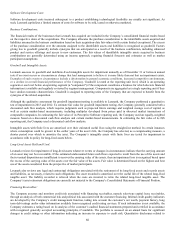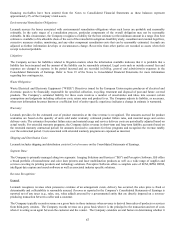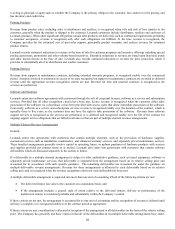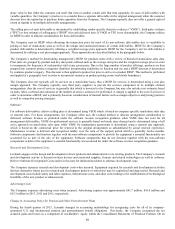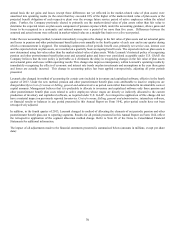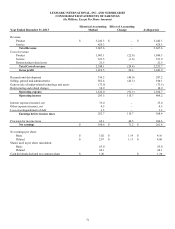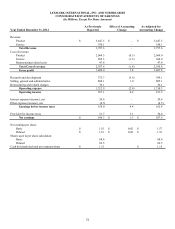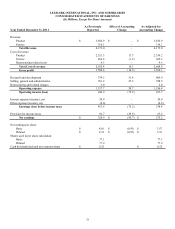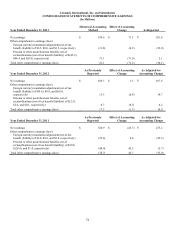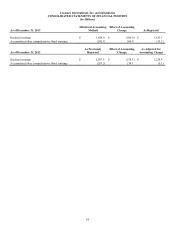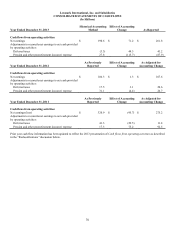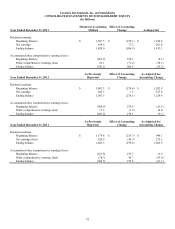Lexmark 2013 Annual Report Download - page 71
Download and view the complete annual report
Please find page 71 of the 2013 Lexmark annual report below. You can navigate through the pages in the report by either clicking on the pages listed below, or by using the keyword search tool below to find specific information within the annual report.
67
financing receivables have been omitted from the Notes to Consolidated Financial Statements as these balances represent
approximately 2% of the Company’s total assets.
Environmental Remediation Obligations:
Lexmark accrues for losses associated with environmental remediation obligations when such losses are probable and reasonably
estimable. In the early stages of a remediation process, particular components of the overall obligation may not be reasonably
estimable. In this circumstance, the Company recognizes a liability for the best estimate (or the minimum amount in a range if no best
estimate is available) of its allocable share of the cost of the remedial investigation-feasibility study, consultant and external legal fees,
corrective measures studies, monitoring, and any other component remediation costs that can be reasonably estimated. Accruals are
adjusted as further information develops or circumstances change. Recoveries from other parties are recorded as assets when their
receipt is deemed probable.
Litigation:
The Company accrues for liabilities related to litigation matters when the information available indicates that it is probable that a
liability has been incurred and the amount of the liability can be reasonably estimated. Legal costs such as outside counsel fees and
expenses are charged to expense in the period incurred and are recorded in Selling, general and administrative expenses in the
Consolidated Statements of Earnings. Refer to Note 19 of the Notes to Consolidated Financial Statements for more information
regarding loss contingencies.
Waste Obligation:
Waste Electrical and Electronic Equipment (“WEEE”) Directives issued by the European Union require producers of electrical and
electronic goods to be financially responsible for specified collection, recycling, treatment and disposal of past and future covered
products. The Company’s estimated liability for these costs involves a number of uncertainties and takes into account certain
assumptions and judgments including collection costs, return rates and product lives. The Company adjusts its liability, as necessary,
when new information becomes known or a sufficient level of entity-specific experience indicates a change in estimate is warranted.
Warranty:
Lexmark provides for the estimated cost of product warranties at the time revenue is recognized. The amounts accrued for product
warranties are based on the quantity of units sold under warranty, estimated product failure rates, and material usage and service
delivery costs. The estimates for product failure rates and material usage and service delivery costs are periodically adjusted based on
actual results. For extended warranty programs, the Company defers revenue in short-term and long-term liability accounts (based on
the extended warranty contractual period) for amounts invoiced to customers for these programs and recognizes the revenue ratably
over the contractual period. Costs associated with extended warranty programs are expensed as incurred.
Shipping and Distribution Costs:
Lexmark includes shipping and distribution costs in Cost of revenue on the Consolidated Statements of Earnings.
Segment Data:
The Company is primarily managed along two segments: Imaging Solutions and Services (“ISS”) and Perceptive Software. ISS offers
a broad portfolio of monochrome and color laser printers and laser multifunction products as well as a wide range of supplies and
services covering its printing products and technology solutions. Perceptive Software offers a complete suite of ECM, BPM, DOM,
intelligent data capture and search software as well as associated industry specific solutions.
Revenue Recognition:
General
Lexmark recognizes revenue when persuasive evidence of an arrangement exists, delivery has occurred, the sales price is fixed or
determinable and collectability is reasonably assured. Revenue as reported in the Company’s Consolidated Statements of Earnings is
reported net of any taxes (e.g., sales, use, value added) assessed by a governmental entity that are directly imposed on a revenue-
producing transaction between a seller and a customer.
The Company typically records revenue on a gross basis in those instances when revenue is derived from sales of products or services
from third-party vendors. The Company records revenue on a gross basis when it is the principal to the transaction and net of costs
when it is acting as an agent between the customer and the vendor. The Company considers several factors in determining whether it
67


